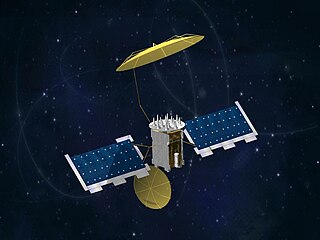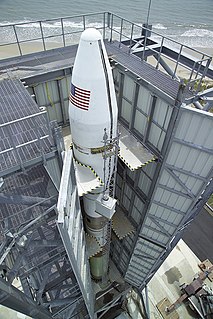Related Research Articles

Ariane 5 is a European heavy-lift space launch vehicle developed and operated by Arianespace for the European Space Agency (ESA). It is launched from the Centre Spatial Guyanais in French Guiana. It has been used to deliver payloads into geostationary transfer orbit (GTO) or low Earth orbit (LEO). The rocket had a streak of 82 consecutive successful launches between 9 April 2003 and 12 December 2017. A direct successor system, Ariane 6, is in development.

The Guiana Space Centre also called Europe's Spaceport is a French and European spaceport to the northwest of Kourou in French Guiana, a region of France in South America. Operational since 1968, it is particularly suitable as a location for a spaceport. It fulfills the two major geographical requirements of such a site:

The Space-Based Infrared System (SBIRS) is a United States Space Force system intended to meet the United States' infrared space surveillance needs through the first two to three decades of the 21st century. The SBIRS program is designed to provide key capabilities in the areas of missile warning, missile defense and battlespace characterization via satellites in geosynchronous Earth orbit (GEO), sensors hosted on satellites in highly elliptical orbit (HEO), and ground-based data processing and control.

Minotaur-C, formerly known as Taurus or Taurus XL, is a four stage solid fueled launch vehicle built in the United States by Orbital Sciences and launched from SLC-576E at California's Vandenberg Air Force Base. It is based on the air-launched Pegasus rocket from the same manufacturer, utilizing a "zeroth stage" in place of an airplane. The Minotaur-C is able to carry a maximum payload of around 1458 kg into a low Earth orbit (LEO).

The Mobile User Objective System (MUOS) is an United States narrowband military communications satellite system that supports a worldwide, multi-service population of users in the ultra high frequency (UHF) band. The system provides increased communications capabilities to newer, smaller terminals while still supporting interoperability with legacy terminals. MUOS is designed to support users who require greater mobility, higher bit rates and improved operational availability. The MUOS was declared fully operational for use in 2019.

SES S.A. is a Luxembourgish satellite and terrestrial telecommunications network provider supplying video and data connectivity worldwide to broadcasters, content and internet service providers, mobile and fixed network operators, governments and institutions.

The Minotaur is a family of United States solid fuel launch vehicles derived from converted Minuteman and Peacekeeper intercontinental ballistic missiles (ICBM). They are built by Northrop Grumman via contract with the Air Force Space and Missile Systems Center's Space Development and Test Directorate (SMC/SD) as part of the Air Force's Rocket Systems Launch Program which converts retired Intercontinental Ballistic Missiles into space and test launch systems for U.S. government agencies.
AMC-3 is a commercial broadcast communications satellite owned by SES World Skies, part of SES S.A.. Launched on 4 September 1997, from Cape Canaveral, Florida, AMC-3 is a hybrid C-band / Ku-band satellite. It provides coverage to Canada, United States, Mexico, Caribbean. Located in a geostationary orbit parallel to the Yucatán Peninsula and Great Lakes, AMC-3 provides service to commercial and government customers, with programming distribution, satellite news gathering and broadcast internet capabilities.
Astra 1K was a communications satellite manufactured by Alcatel Space for SES. When it was launched on 25 November 2002, it was the largest civilian communications satellite ever launched, with a mass of 5,250 kg (11,570 lb). Intended to replace the Astra 1B satellite and provide backup for 1A, 1C and 1D at the Astra 19.2°E orbital position, the Blok DM-03 upper stage of the Proton-K launch vehicle failed to function properly, leaving the satellite in an unusable parking orbit.
AMC-4 is a commercial broadcast communications satellite owned by SES World Skies, part of SES S.A.. Launched in 1999, from Centre Spatial Guyanais, ELA-2 by Ariane 44LP H10-3. It provides coverage to North America, Latin America, Caribbean. Located in a geostationary orbit, AMC-4 provides service to commercial and government customers, with programming distribution, satellite news gathering and broadcast internet capabilities.
AMC-7 is a commercial broadcast communications satellite owned by SES S.A., originally from the GE Americom fleet. Launched on 14 September 2000, at 22:54:07 UTC from the Centre Spatial Guyanais in Kourou, AMC-7 provides C-band coverage to United States, Caribbean, Mexico, and is located in a geostationary orbit over the Pacific Ocean east of Hawaii. The satellite is primarily used for cable television programming distribution.

Minotaur IV, also known as Peacekeeper SLV and OSP-2 PK is an active expendable launch system derived from the LGM-118 Peacekeeper ICBM. It is operated by Northrop Grumman Innovation Systems, and made its maiden flight on 22 April 2010, carrying the HTV-2a Hypersonic Test Vehicle. The first orbital launch occurred on 26 September 2010 with the SBSS satellite for the United States Air Force.
The AMC-5, originally called GE-5, was a geosynchronous direct-broadcast satellite (DBS) located at 79° West longitude, operated by SES Americom in the Ku-band. It was used by a variety of television customers, including being home to the CBS Newspath service.
A hosted payload is a module attached to a commercial satellite with communications circuitry that operates independently of the main spacecraft but which shares the satellite's power supply and transponders. The concept has been also been referred to as "piggybacking" or "hitchhiking."
SES-7 is a commercial communications satellite operated by SES World Skies, then SES S.A.
SES-5 is a commercial geostationary communication satellite operated by SES S.A.. It was launched on 9 July 2012. The launch was arranged by International Launch Services (ILS).

Global-scale Observations of the Limb and Disk (GOLD) is a heliophysics Mission of Opportunity (MOU) for NASA's Explorers program. Led by Richard Eastes at the Laboratory for Atmospheric and Space Physics, which is located at the University of Colorado Boulder, GOLD's mission is to image the boundary between Earth and space in order to answer questions about the effects of solar and atmospheric variability of Earth's space weather. GOLD was one of 11 proposals selected, of the 42 submitted, for further study in September 2011. On 12 April 2013, NASA announced that GOLD, along with the Ionospheric Connection Explorer (ICON), had been selected for flight in 2017. GOLD, along with its commercial host satellite SES-14, launched on 25 January 2018.

SES-10, is a geostationary communications satellite awarded in February 2014, owned and operated by SES S.A. and designed and manufactured by Airbus Defence and Space on the Eurostar-3000 satellite bus. It is positioned at the 67° West position thanks to an agreement with the Andean Community to use the Simón Bolivar-2 satellite network. It replaces AMC-3 and AMC-4 to provide enhanced coverage and significant capacity expansion.
Galaxy 30 is a communications satellite owned by Intelsat located at 125° West longitude, serving the North America market. It was built by Orbital ATK, as part of its GEOStar-2 line. Galaxy 30 was formerly known as Galaxy 14R. This satellite provides services in the C-band, Ku-band, and Ka-band.
References
- ↑ "Launch Log". Jonathan's Space Report. 14 March 2021. Retrieved 11 April 2021.
- 1 2 3 4 "Display: SES-2 2011-049A". NASA. 5 April 2021. Retrieved 11 April 2021.
 This article incorporates text from this source, which is in the public domain.
This article incorporates text from this source, which is in the public domain. - ↑ "Money-saving missile detection sensor powered on". Spaceflight Now. 4 November 2011. Retrieved 11 April 2021.
- ↑ "Hosted Success Air Force Plans Follow-On". SpaceNews. Archived from the original on 13 September 2012.
- ↑ "Hosted payloads". NOAA. Archived from the original on 25 June 2014. Retrieved 11 April 2021.
 This article incorporates text from this source, which is in the public domain.
This article incorporates text from this source, which is in the public domain. - ↑ "SES 2 at 87.0°W". LyngSat. Retrieved 11 April 2021.
- ↑ "User's Guide to Setting Up and Using Othernet Dreamcatcher v 3.03" (PDF). cdn.shopify.com. 14 January 2019. Retrieved 11 April 2021.